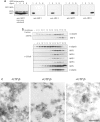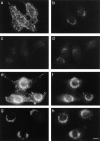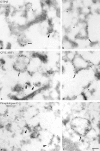The role of ADP-ribosylation factor and phospholipase D in adaptor recruitment
- PMID: 9298980
- PMCID: PMC2132562
- DOI: 10.1083/jcb.138.6.1239
The role of ADP-ribosylation factor and phospholipase D in adaptor recruitment
Abstract
AP-1 and AP-2 adaptors are recruited onto the TGN and plasma membrane, respectively. GTPgammaS stimulates the recruitment of AP-1 onto the TGN but causes AP-2 to bind to an endosomal compartment (Seaman, M.N.J., C.L. Ball, and M.S. Robinson. 1993. J. Cell Biol. 123:1093-1105). We have used subcellular fractionation followed by Western blotting, as well as immunofluorescence and immunogold electron microscopy, to investigate both the recruitment of AP-2 adaptors onto the plasma membrane and their targeting to endosomes, and we have also examined the recruitment of AP-1 under the same conditions. Two lines of evidence indicate that the GTPgammaS-induced targeting of AP-2 to endosomes is mediated by ADP-ribosylation factor-1 (ARF1). First, GTPgammaS loses its effect when added to ARF-depleted cytosol, but this effect is restored by the addition of recombinant myristoylated ARF1. Second, adding constitutively active Q71L ARF1 to the cytosol has the same effect as adding GTPgammaS. The endosomal membranes that recruit AP-2 adaptors have little ARF1 or any of the other ARFs associated with them, suggesting that ARF may be acting catalytically. The ARFs have been shown to activate phospholipase D (PLD), and we find that addition of exogenous PLD has the same effect as GTPgammaS or Q71L ARF1. Neomycin, which inhibits endogenous PLD by binding to its cofactor phosphatidylinositol 4,5-bisphosphate, prevents the recruitment of AP-2 not only onto endosomes but also onto the plasma membrane, suggesting that both events are mediated by PLD. Surprisingly, however, neither PLD nor neomycin has any effect on the recruitment of AP-1 adaptors onto the TGN, even though AP-1 recruitment is ARF mediated. These results indicate that different mechanisms are used for the recruitment of AP-1 and AP-2.
Figures












Similar articles
-
ADP-Ribosylation factor 1 (ARF1) regulates recruitment of the AP-3 adaptor complex to membranes.J Cell Biol. 1998 Jul 27;142(2):391-402. doi: 10.1083/jcb.142.2.391. J Cell Biol. 1998. PMID: 9679139 Free PMC article.
-
ADP-ribosylation factor 1 transiently activates high-affinity adaptor protein complex AP-1 binding sites on Golgi membranes.Mol Biol Cell. 1998 Jun;9(6):1323-37. doi: 10.1091/mbc.9.6.1323. Mol Biol Cell. 1998. PMID: 9614177 Free PMC article.
-
Characteristics of protein-kinase-C- and ADP-ribosylation-factor-stimulated phospholipase D activities in human embryonic kidney cells.Eur J Biochem. 1997 Sep 1;248(2):407-14. doi: 10.1111/j.1432-1033.1997.00407.x. Eur J Biochem. 1997. PMID: 9346296
-
Activation of toxin ADP-ribosyltransferases by the family of ADP-ribosylation factors.Adv Exp Med Biol. 1997;419:315-20. doi: 10.1007/978-1-4419-8632-0_41. Adv Exp Med Biol. 1997. PMID: 9193671 Review.
-
Phospholipase D in endocytosis and endosomal recycling pathways.Biochim Biophys Acta. 2009 Sep;1791(9):845-9. doi: 10.1016/j.bbalip.2009.05.011. Epub 2009 Jun 18. Biochim Biophys Acta. 2009. PMID: 19540357 Free PMC article. Review.
Cited by
-
ADP-Ribosylation factor 1 (ARF1) regulates recruitment of the AP-3 adaptor complex to membranes.J Cell Biol. 1998 Jul 27;142(2):391-402. doi: 10.1083/jcb.142.2.391. J Cell Biol. 1998. PMID: 9679139 Free PMC article.
-
ARF6 stimulates clathrin/AP-2 recruitment to synaptic membranes by activating phosphatidylinositol phosphate kinase type Igamma.J Cell Biol. 2003 Jul 7;162(1):113-24. doi: 10.1083/jcb.200301006. J Cell Biol. 2003. PMID: 12847086 Free PMC article.
-
An ADP-ribosylation factor GTPase-activating protein Git2-short/KIAA0148 is involved in subcellular localization of paxillin and actin cytoskeletal organization.Mol Biol Cell. 2001 Mar;12(3):645-62. doi: 10.1091/mbc.12.3.645. Mol Biol Cell. 2001. PMID: 11251077 Free PMC article.
-
Regulation of KCNQ2/KCNQ3 current by G protein cycling: the kinetics of receptor-mediated signaling by Gq.J Gen Physiol. 2004 Jun;123(6):663-83. doi: 10.1085/jgp.200409029. J Gen Physiol. 2004. PMID: 15173220 Free PMC article.
-
The Arf-GTPase-activating protein Gcs1p is essential for sporulation and regulates the phospholipase D Spo14p.Eukaryot Cell. 2006 Jan;5(1):112-24. doi: 10.1128/EC.5.1.112-124.2006. Eukaryot Cell. 2006. PMID: 16400173 Free PMC article.
References
-
- Ball CL, Hunt SP, Robinson MS. Expression and localisation of α-adaptin isoforms. J Cell Sci. 1995;108:2865–2875. - PubMed
-
- Barlowe C, Orci L, Yeung T, Hosobuchi M, Hamamoto S, Salama N, Rexach MF, Ravazzola M, Amherdt M, Schekman R. COPII: a membrane coat formed by sec proteins that drive vesicle budding from the endoplasmic reticulum. Cell. 1994;77:895–907. - PubMed
-
- Beck KA, Keen JH. Interaction of phosphoinositide cycle intermediates with the plasma membrane-associated clathrin assembly protein AP-2. J Biol Chem. 1991;266:4442–4447. - PubMed
-
- Bi K, Roth MG, Ktistakis NT. Phosphatidic acid formation by phospholipase D is required for transport from the endoplasmic reticulum to the Golgi complex. Curr Biol. 1997;7:301–315. - PubMed
Publication types
MeSH terms
Substances
LinkOut - more resources
Full Text Sources
Research Materials
Miscellaneous

